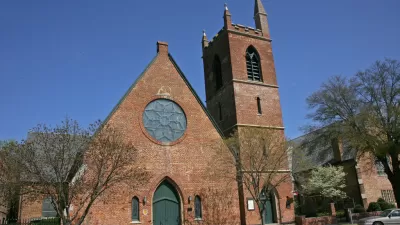New research shows areas with a heavy concentration of commercial offices experience 40 percent higher crime rates than neighborhoods that mix residential and commercial uses.

According to an article by Kaley Overstreet in Arch Daily, “mixed-use spaces do more than just create a diverse array of experiences in cities- they might also help contribute to lower crime rates.” Mixed-Use neighborhoods, writes Overstreet, “enhance social connections and promote public transportation, while also encouraging the themes of ‘live, work, and play’ in one concentrated zone.”
According to Overstreet, “In a study published under the University of Pennsylvania Law Review, data showed that it’s more likely that neighborhoods with local cafes, bars, offices, and residential areas are inherently more likely to have more ‘eyes on the street’ at more hours of the day. The collective public surveillance may deter criminals.” In the same study, “The areas where commercial offices were heavily focused experienced over 40% more crime than in other neighborhoods, especially those that included residences.”
The research concluded that it makes sense that residents may feel a greater sense of ownership for the neighborhoods where they live versus neighborhoods where they solely work, and when those two have some sort of overlap, people still feel protective of the bars, restaurants, and stores that they consider to be in their neighborhood.
Overstreet points out that “What this tells urban planners and architects is that zoning laws may be a contributing factor and an important tool for helping prevent crime in cities.”
FULL STORY: How Mixed-Use Neighborhoods Can Reduce Crime Rates

Planetizen Federal Action Tracker
A weekly monitor of how Trump’s orders and actions are impacting planners and planning in America.

Congressman Proposes Bill to Rename DC Metro “Trump Train”
The Make Autorail Great Again Act would withhold federal funding to the system until the Washington Metropolitan Area Transit Authority (WMATA), rebrands as the Washington Metropolitan Authority for Greater Access (WMAGA).

The Simple Legislative Tool Transforming Vacant Downtowns
In California, Michigan and Georgia, an easy win is bringing dollars — and delight — back to city centers.

The States Losing Rural Delivery Rooms at an Alarming Pace
In some states, as few as 9% of rural hospitals still deliver babies. As a result, rising pre-term births, no adequate pre-term care and "harrowing" close calls are a growing reality.

The Small South Asian Republic Going all in on EVs
Thanks to one simple policy change less than five years ago, 65% of new cars in this Himalayan country are now electric.

DC Backpedals on Bike Lane Protection, Swaps Barriers for Paint
Citing aesthetic concerns, the city is removing the concrete barriers and flexposts that once separated Arizona Avenue cyclists from motor vehicles.
Urban Design for Planners 1: Software Tools
This six-course series explores essential urban design concepts using open source software and equips planners with the tools they need to participate fully in the urban design process.
Planning for Universal Design
Learn the tools for implementing Universal Design in planning regulations.
Smith Gee Studio
City of Charlotte
City of Camden Redevelopment Agency
City of Astoria
Transportation Research & Education Center (TREC) at Portland State University
US High Speed Rail Association
City of Camden Redevelopment Agency
Municipality of Princeton (NJ)




























